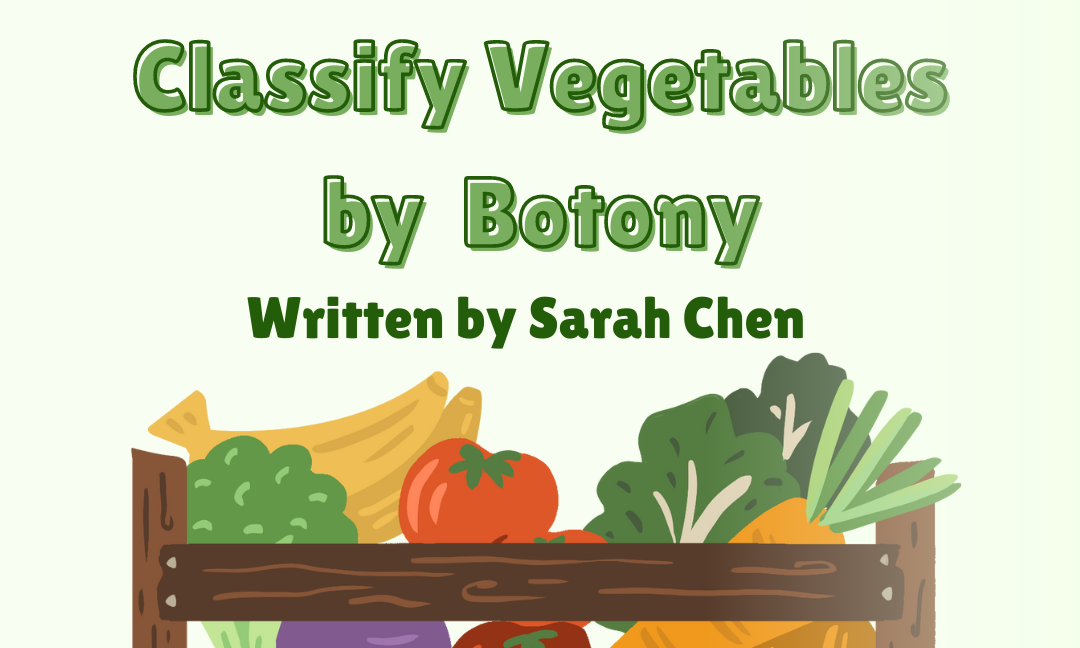Written by Sarah Chen
Edited by Kiritika Rana
Designed by Alessa Zaitseva
Published by Kiritika Rana
Botany is a branch of Biology, and it is the science of plants. Classify vegetables by botany. Today we are going to talk about classifying vegetables by botany. Usually in daily life, people refer to edible parts of the plants as vegetables and fruits. In most cases, the salty ones are often cooked and are defined as vegetables, while the sweet ones are usually eaten raw and are defined as fruits. However, the classification of vegetables in botany has some differences. Let’s delve into a more detailed explanation.

At the very beginning, before classifying vegetables, let’s distinguish vegetables and fruits botanically. Fruits and vegetables are classified according to which part of the plant they come from. Fruits and vegetables may grow on different parts of the plant. Among them, fruits are developed from the flowers of plants and contain seeds. Flowers contain the reproductive parts of a plant, The reproductive part develops into seeds through pollination, while the surrounding parts develop into fruits. And other parts of the plant are vegetables. On the basis of this standard, regardless of strawberries, pears, apples, watermelons…… These things we usually call fruits are also fruits in botany. And many nuts are also fruits, but this is beyond the scope of our discussion today. This also means that the squashes, peppers, tomatoes, cucumbers, zucchinis, corn and so on are actually fruits botanically instead of vegetables or grains, because they also develop from flowers. So our following discussion will not include them.
In botany, vegetables can be classified in various ways based on different botanical characteristics. We will first talk about plant families. A plant family group related plants with the same characteristics and evolutionary origins together. Now, focus on plant families with vegetables and look at some examples. The Brassicaceae, also called Cruciferae family, includes cabbages, radishes, watercress, and many others. Their common feature is having flowers with four petals that look like a cross. The Chenopodiaceae family comprises vegetables like swiss chards, spinach and beets, characterized by chiefly shrubs, leaves simple, flowers small and without stipules. The Fabaceae family is a group of flowering plants, members include peas, beans, lentils and peanuts, typically pentamerous flowers and often compound leaves. The Umbelliferae family have flowers arranged in umbels, and are mostly aromatic plants with hollow stems, and the vegetables in the Umbelliferae family(also called Apiaceae family) include carrots, celery, fennel and parsley.
There are many other plant families like the Rosaceae family, Poaceae family, Cucurbitaceae family…… But we will learn about plant structures next. Vegetables can be distinguished based on the parts of the plant we eat. Roots, stems, leaves and flowers all represent different edible structures. We have said before that whether apples or zucchinis, they are fruits in botany since they develop from the flowers of plants. And for vegetables, carrots, radishes, etc. are examples of root vegetables. Celery, asparagus, etc. are stem vegetables. Spinach, lettuce, etc. are leaf vegetables. The reason is obvious since carrots and radishes grow underground, celery and asparagus mainly eat the stem part of the plants by people, and spinach and lettuce are edible on the leaf part.
Our next topic will be the life cycle. Living organisms have life cycles, and so do vegetables. They can be classified as annuals, biennials, or perennials. Annuals, like lettuce, complete their life cycle in a single year. Biennials, such as carrots, take two years, while perennials including asparagus persist for several years. Knowing this helps farmers plan when to plant and harvest their crops.
Now coming to our last topic, there’s genus and species for vegetables. Each vegetable belongs to a specific genus and species, explained using a simile, these are like their unique last names(genus) and first(species). The scientists use two special parts called the genus and the species to give each vegetable its own identity. Let’s take carrots as an example. The full name for carrots is Daucus Carota. “Daucus” is the genus, and “Carota” is the species. Remember we said above that carrots are in the Umbelliferae/Apiaceae family when we were talking about plant families? Daucus is a genus of the Umbelliferae family! Genus also relate plants by same characteristics like plant families, and plants in Daucus are mainly biennial. Thus, genus and species help us understand the special features of each vegetable and how they’re connected to other plants in the big plant family.
Finally, to summarize, we’ve been talking about the definition of vegetables and fruits in botany, plant family, plant structures, life cycle, genus and species. I’m glad and grateful that you’ve read this far. This blog just talks about some basic knowledge. I hope it is helpful. Thank you for reading this blog!
References:
https://www.sciencedirect.com/topics/pharmacology-toxicology-and-pharmaceutical-science/apiaceae
https://lawnlove.com/blog/difference-between-annual-perennial-biennial-plants/

